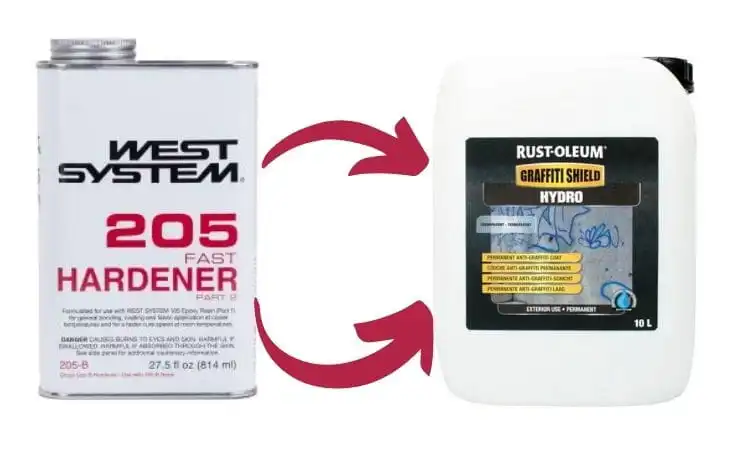There are several types of paint and stage categories that need different treatments for efficiency. Whether your paint is lacquer, enamel, epoxy, urethane, powder, or something else, there is nothing wrong with knowing the details of adding hardener to rustoleum paint.
Synthetic enamel includes single-stage paint that does not require a hardener. You can do the paint job without having or using any hardener on it. However, a hardener can be used or added sometimes based on the paint type. For example, acrylic enamel paints require hardeners to be used often to increase durability and performance.
Here you must know the basic differences between enamel paint and acrylic paint to understand the concept of adding hardener in rustoleum paint successfully.
Clear concept of adding hardener to rustoleum paint
The mix-up plays a vital role in the comparison of enamel vs acrylic paints. Many people have a misconception that tells them to consider these two types of paints as the opposite. This common misconception should be changed. The root of this wrong idea is the nature of enamel and acrylic paints. Enamel is oil-based and acrylic is water-solvable. The alternative does not mean the opposite behavior instead of considering the refinishing terms.
The purpose of adding the hardener to rustoleum paints is to promote the drying time faster. The mixing period is a significant aspect of the whole paint job. Adding too little or too much than required can create unwanted dry patches, sags, and runs in the paintwork.
Follow the appropriate steps of hardener mixture in rustoleum paint below.
- The paint mixing jar should be wiped out with a soft and clean cloth to eliminate the traces of rust and other foreign particles. Choose a flat and smooth surface to place the mixing jar correctly.
- Before the mixing process, mix the automotive paint systematically by using a disposable moving stick. You must ensure the proper mixture of separate pigments and color accuracy as well.
- Establish the accurate mixing ratio with the help of automotive paint referring technical statistics sheet. The ratio should be 2:1:1 which means 2 sections of paints, 1 section of reducer, and 1 section of hardener.
- Determine the number of unmixed materials that are required for painting. The moving paint stick can be used to note the different sizes of measurements. Make a mark based on the liter of unmixed paint.
- Consider a box of compatible hardeners and follow the center marks of the moving stick that show the second section of the mix ratio.
Can acrylic hardeners be used in synthetic paint?
No products found.
Hardener can be added to every coat of paint if it will be used in single-stage paint. Though it is added to only a few clear coat or base coat products, it is highly required for acrylic enamel paints. Using partial hardeners that can cause cracks or chips is not expected at all.
Make sure that the paint and reducer belong to the same manufacturer before mixing them up. As we mentioned earlier that hardener is being used for faster drying moments. It increases the paint adhesion and brings good results in the future.
Nothing is expected to appear more or less than average. Hardeners also follow the path as it can create disturbance if the mixing ratio gets inaccurate. Multiple defects can take place if too much activator is being used. Excessive heat can occur crack or other imperfect situations due to its nature and also the humidity impacts.
How to make a paint hardener?
Paint hardener generally comes in a packet from the market that is used mainly to harden or strengthen up the latex paint. Usually, the paint becomes 1 gallon of packed which needs the hardener mixed with a perfect ratio. Water is needed for the hardener activation in this case. 1 cup of water is required for the proper mixture and then you must move it. Leave the paint can for 30 minutes alone.
Best parts of paint hardener user’s manual
There are several options of hardeners in the market for latex paints. We recommend using an HDX hardener to make the fluid paint harden up. The components sometimes need solid treatment that cures the paint quickly. A poor-quality product won’t provide that support ultimately.
In the case of oil-based paints, you can let their unstable contents disappear in an exposed area that has proper ventilation. Then allow the remaining liquids for mixing and let them harden correctly. Keep your children and pets away from the area specifically when the paints are about to dry.
If you need to spray the rustoleum paint, you probably need to make it thin. There are several mineral spirits that you can use for the thinning process of rustoleum paint. Generally, hardeners are not used in enamel paints except automotive paints. We suggest you to think of the inevitability first before purchasing or applying a hardener on rustoleum.
Is a 2K hardener can be added to enamel paint?
First of all, single-stage paint doesn’t require a hardener to be used often except customer’s choice. Synthetic enamel belongs to single-stage paint that also maintains the same criteria for hardener practice. Acrylic enamel encourages hardeners to increase durability and reduce the dryness period.
Tools and parts you need for hardener in automotive paint
After getting buckets for paint mixing, and the paint mover tool, you will go for the parts of the paint including, paint, thinner, activator, and hardener. The thinner and the reducer are the same in different names. The activator and hardener act almost the same to cure the 2K products.
Conclusion
A hardener plays a role of components that is full of certain mixtures. Sometimes, it can be used to increase the flexibility of mixing paint. Sometimes, it works as a curative component. In both cases, a hardener is a chemical reaction that enables a faster drying period and durability.

